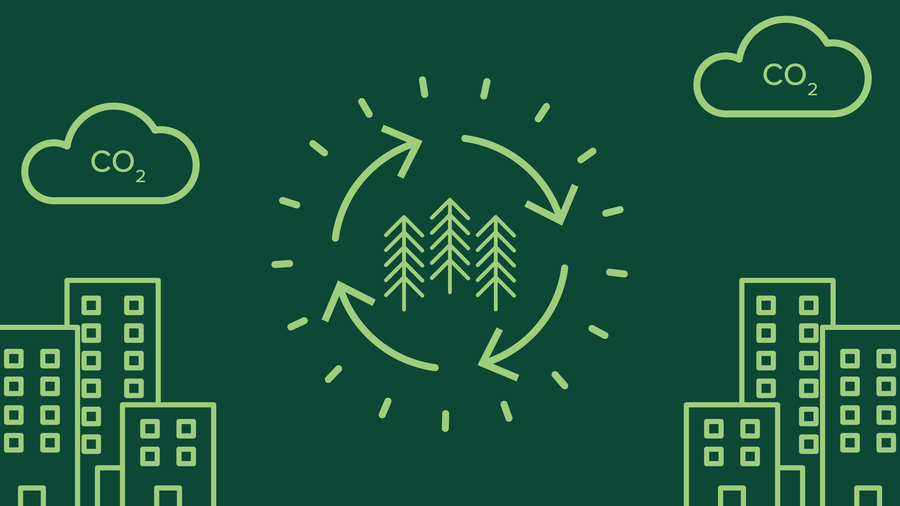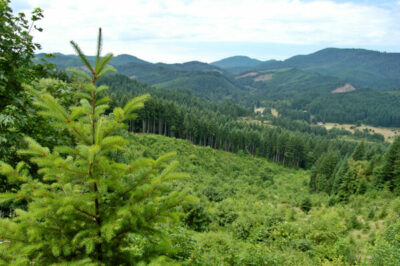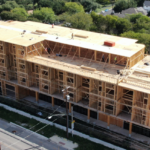Expert Tips
When to Include Biogenic Carbon in an LCA
Part 1 in a series on biogenic carbon accounting for wood products – an overview of biogenic carbon accounting practices as defined by international standards

Biogenic carbon accounting practices are described in the international standard, ISO 21930, which governs environmental product declarations (EPDs) for construction products.1 Biogenic carbon is defined as “carbon derived from… material of biological origin excluding material embedded in geological formations or transformed to fossilized material and excluding peat.” In the context of wood construction products, this is the carbon sequestered by the tree as it grows that continues to be stored in the wood product over its lifetime.
ISO 21930 section 7.2.7 states:
Bio-based materials originating from renewable resources… contain biogenic carbon. The mass flows to and from nature and biogenic carbon removal(s) and emissions throughout the product system shall be reported as a flow of biogenic carbon…”
Specifically, it states that biogenic carbon entering the system shall be characterized with a factor of -1 (i.e., a reduction in carbon emissions), which represents the removal of carbon from the atmosphere that occurs as a tree grows. When the material burns or decays, some or all of that stored carbon is released back to the atmosphere and must be characterized with a factor of +1 (i.e., a carbon emission). Similarly, any time a material containing biogenic carbon leaves the system, the carbon is also characterized with a factor of +1.

Simply put, when biogenic carbon enters a system, it is reported as a negative value; when it leaves the system, it is reported as a positive value. Using this “-1 in/+1 out” accounting practice in accordance with ISO 21930 is what designers commonly mean when they say they are “including biogenic carbon.”
The standard language above references “bio-based materials originating from renewable resources.” This is reiterated later in the same section:
For wood, biogenic carbon may be characterized with a -1 kg CO2e/kg CO2 biogenic carbon flow when entering the product system only when the wood originates from sustainably managed forests (see also NOTE 2 in 7.2.11).
Note 2 of Section 7.2.11 states:
The concept of sustainably managed forests is linked but not limited to respective certification schemes. Other evidences such as national reporting under the United Nations Framework Convention on Climate Change (UNFCCC) can be used to identify forests with stable or increasing forest carbon stocks.
Under this definition, all U.S. and Canadian lumber is considered to be sourced from sustainably managed forests due to the fact that the forest carbon stock in each country has been increasing since 1990 when reporting began. (U.S. data is per the EPA’s Inventory of U.S. Greenhouse Gas Emissions and Sinks report published in 2021.2 Canadian data is per the National Inventory Report of Greenhouse Gas Sources and Sinks in Canada.3) Additionally, data from the USDA’s Forest Inventory and Analysis Program shows that U.S. forestland area has been stable for more than 100 years and that the volume of standing inventory in those forests has increased 60 percent in the past 60 years.4
Therefore, based on the international standards that govern biogenic carbon accounting practices, it is appropriate to report the biogenic carbon flows as part of the LCA. This is true for all wood coming from the U.S. and Canada based on national reporting. For wood coming from other countries, designers may either specify lumber sourced in accordance with standards developed by third-party certification programs5, per Section 7.2.11, or rely on UNFCCC national reporting data for that country of origin. For more information on LCA and the sustainability of wood buildings, see the expert tip, Introduction to Whole Building Life Cycle Assessment: The Basics.
For how to include biogenic carbon in an LCA see Part 2. For specifics on how WBLCA tools account for biogenic carbon, see Part 3. For a discussion on the additional benefits of long-term biogenic carbon storage, see Part 4.
Additional Resources
Salazar, J. Carbon Leadership Forum. (2020, May). Wood Carbon Seminars: How LCA Handles Wood.
Think Wood. (2021, February). Understanding the Role of Embodied Carbon in Climate Smart Buildings.
1 International Organization for Standardization. (2017). Sustainability in buildings and civil engineering works – Core rules for environmental product declarations of construction products and services (ISO 21930:2017).
2 Inventory of U.S. Greenhouse Gas Emissions and Sinks, Table 6-10.
3 National Inventory Report 1990-2019: Greenhouse Gas Sources and Sinks in Canada, Table 6-1.
4Oswalt, S. N., Miles, P. D., Pugh, S. A., & Smith, W. B. (2018). Forest Resources of the United States, 2017: A Technical Document Supporting the Forest Service 2020 Update of the RPA Assessment. U.S. Department of Agriculture, Forest Service.
5Note that this includes products sourced in accordance with responsible sourcing standards, such as the FSC Controlled Wood Standard or the SFI Fiber Sourcing Standard, as well as chain-of-custody standards, such as the FSC Chain-of-Custody Standard, SFI Chain-of-Custody Standard, or PEFC Chain-of-Custody Standard.


